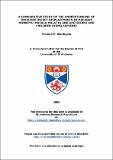A comparative study of the understanding of invisible object displacements in macaque monkeys (Macaca mulatta and arctoides) and children (Homo sapiens)
Abstract
The ability to infer the invisible displacement of objects has long been thought to elude most species with the exception of humans and great apes. However, in recent years, a number of researchers have proposed that this elusive capacity, rather than reflecting profound differences in the conceptual abilities of monkeys and other nonprimates, may instead reflect differences in processing capacities (such as inhibition and working memory). This thesis investigated knowledge of occluded object movements involving gravity, in rhesus and stumptail macaques (Macaca mulatta and arctoides), and two- and three-year-old children (Homo sapiens). In the first part of the thesis, using manual search tasks, a behavioural analysis revealed a number of biases that influence search on invisible displacement tasks, but also showed that contrary to the contentions of some authors, these biases do not mask the existence of correct representations. One study did reveal how seemingly mundane differences between tasks might lead to markedly different patterns of search and emergence of biases. In the second part of the thesis, in the first direct test of the prediction-postdiction hypothesis, an analysis of anticipatory eye gaze suggested that an inability to predict the location of an object does not account for the looking-searching dissociation that has become so prevalent in both the developmental and comparative literature. In attempting to bring together the findings from all the chapters, a framework is suggested in which representations are viewed as differing in strength such that the strength of a representation may determine whether or not a pre-existing bias surfaces in behaviour.
Type
Thesis, PhD Doctor of Philosophy
Collections
Items in the St Andrews Research Repository are protected by copyright, with all rights reserved, unless otherwise indicated.

